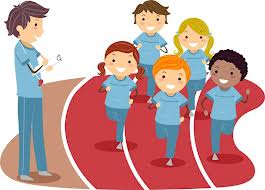 Many Physical Educators are now in the midst of their physical fitness tests across the nation. Just like classroom teachers, we need to do a “pre” and “post” assessment in order to not only evaluate our students, but also our planning and classroom strategies used throughout the year. Part of the testing process has to be an analysis of the data across the school and allowing a teacher to assess their teaching methods and effectiveness. Before we get to testing strategies, let’s get up to speed on current events in fitness testing.
Many Physical Educators are now in the midst of their physical fitness tests across the nation. Just like classroom teachers, we need to do a “pre” and “post” assessment in order to not only evaluate our students, but also our planning and classroom strategies used throughout the year. Part of the testing process has to be an analysis of the data across the school and allowing a teacher to assess their teaching methods and effectiveness. Before we get to testing strategies, let’s get up to speed on current events in fitness testing.
In a recent webinar I conducted, only half the P.E. teachers knew that this will be the last year of the President’s Challenge Test. This is the test my generation grew up on. The President’s Challenge rewarded only the highly fit/skilled student with a President’s or National Award. This program is being renamed the President’s Youth Fitness Program or PYFP. In this re-branding, the actual test is being replaced with the Fitnessgram assessment from the Cooper Institute.
The Fitnessgram test differs from the President’s Challenge in that students are striving to reach the “Healthy Fitness Zone”, rather than a norm referenced criteria each student tries to meet. In my opinion, the theory behind this is to give the less fit students more realistic goals to achieve a proper level of fitness. For example, if I am a 12 year old boy and I can do 5 push ups, I have to reach 18 to qualify for a National Award or 31 to get Presidential. Neither of those goals are going to seem reasonable for me to achieve in a nine week grading period or school year. However, I only need to do 10-20 to be in the Healthy Fitness Zone (HFZ). This is a much more realistic goal, especially over the course of a school year! While I feel this a great advantage to the Fitnessgram test, I wish there were numbers set for highly fit students to qualify for with distinction.
There are many possible components to use on the Fitnessgram. I will focus on the tests that Georgia has mandated for student data. In muscular strength and endurance, we use curl ups and push ups. A huge difference in between Fitnessgram and the old President’s Challenge is that these are done to a cadence. A CD or audio file can be used with Fitnessgram’s cadence. Students must execute the move correctly and with the cadence. A participant gets two mistakes before their test is over. For curl ups, there is a strip (or you can use floor tape) that designates the distance their fingers must slide along the floor. Student errors include pulling on their pants, pushing off on elbows or hands, and not laying flat between curl ups. Student push up errors include not reaching a 90 degree angle with the elbows or a body part touching the floor other than hands and toes. The participant continues testing after their first error. On the second error, they are done. On “trick” that we use to help monitor errors is the “yellow/red card” system. When a student makes their first error, we drop a yellow index card by them and try to tell them the mistake. A red card is given to the student on their second mistake and we tell them their score. It is an easy visual to let the students and teachers know who has mistakes.
The PACER is our test to help measure VO2 max. There is an option to run the mile, but in a classroom setting the PACER is a much better choice because you do not have to spread teachers and students over a large area. You need a 20 meter distance to run the PACER so it does not require a lot of room. The students run the distance to a series of timed bells. Success is dictated by whether or not you make it by the bell. In the beginning, participants have roughly nine seconds to travel the distance. After each minute of the test, they have less time to complete the 20 meters. Once again, they are eliminated from the test on their second mistake. A mistake is simply not covering the distance before the bell rings so it is pretty easy to monitor. There are a lot of fun ways to practice the PACER that students enjoy and it helps get them accustomed to the test and series of bells.
In conjunction with PACER, height and weight are measured to help calculate the VO2 max. Proper procedure MUST be used to ensure student privacy is upheld. Students will take off their shoes for both measurements. Also, they can remove bulky sweatshirts or coats for weighing. We measure height against a wall and then they step on a scale just inside our equipment room. The teacher stays outside the room, but we can see the weight on the scale. The student can look at the number, if desired. The teacher does not verbalize the weight, but does write or enter it on the student’s record. Many issues can be avoided with students and parents by setting up a good protocol to follow in order to maintain privacy and trust.
The last test we are required to do is the sit and reach test to measure flexibility at the hip joint. Students get three tries with each foot against the sit and reach box. Their score is the best of the three tries. The leg being tested must remain straight and the “off” leg is bent with the foot on the floor next to the knee at a distance of one fist away. Visuals are really effective in teaching students the proper technique. We utilize photos on our iPads shown via the LCD projector to enhance student learning.
A great part about Fitnessgram is it will compile all the data on to a spreadsheet for teachers to sort and examine. This will enable you to analyze your students and look for their strengths and weakness. Additionally, you can see if there are specific areas that may need to be focused on with better planning during the school year. Parent reports are simple to print and you can set it up to have “pre” and “post” test data together so they can get a better picture of their child’s fitness levels.
Overall, I have enjoyed working with Fitnessgram and find the test to be pretty easy to administer. There is some “training” of the students to make things run smoothly, but once a group is “trained” they will remember with brief reminders. Fitnessgram will definitely help students that are not very fit. I used this test for the first time at a “high needs/low fitness” middle school and the results that we achieved were astounding. The HFZ really hits home with the students and they realize they need a basic amount of fitness to lead a healthy life. If you are an old school President’s Challenge person, I encourage you to give Fitnessgram a try and you may get some surprising results!
[/fusion_builder_column][/fusion_builder_row][/fusion_builder_container]




